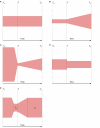This is a preprint.
Population Genomics of Plasmodium malariae from Four African Countries
- PMID: 39314932
- PMCID: PMC11419228
- DOI: 10.1101/2024.09.07.24313132
Population Genomics of Plasmodium malariae from Four African Countries
Abstract
Plasmodium malariae is geographically widespread but neglected and may become more prevalent as P. falciparum declines. We completed the largest genomic study of African P. malariae to-date by performing hybrid capture and sequencing of 77 isolates from Cameroon (n=7), the Democratic Republic of the Congo (n=16), Nigeria (n=4), and Tanzania (n=50) collected between 2015 and 2021. There is no evidence of geographic population structure. Nucleotide diversity was significantly lower than in co-localized P. falciparum isolates, while linkage disequilibrium was significantly higher. Genome-wide selection scans identified no erythrocyte invasion ligands or antimalarial resistance orthologs as top hits; however, targeted analyses of these loci revealed evidence of selective sweeps around four erythrocyte invasion ligands and six antimalarial resistance orthologs. Demographic inference modeling suggests that African P. malariae is recovering from a bottleneck. Altogether, these results suggest that P. malariae is genomically atypical among human Plasmodium spp. and panmictic in Africa.
Conflict of interest statement
Competing interests: JBP reports research support from Gilead Sciences, non-financial support from Abbott Laboratories, and consulting for Zymeron Corporation, all outside the scope of the current manuscript.
Figures




Similar articles
-
Low prevalence of Plasmodium malariae and Plasmodium ovale mono-infections among children in the Democratic Republic of the Congo: a population-based, cross-sectional study.Malar J. 2016 Jul 8;15:350. doi: 10.1186/s12936-016-1409-0. Malar J. 2016. PMID: 27392905 Free PMC article.
-
Plasmodium malariae structure and genetic diversity in sub-Saharan Africa determined from microsatellite variants and linked SNPs in orthologues of antimalarial resistance genes.Sci Rep. 2022 Dec 19;12(1):21881. doi: 10.1038/s41598-022-26625-w. Sci Rep. 2022. PMID: 36536036 Free PMC article.
-
Epidemiology of Plasmodium malariae and Plasmodium ovale spp. in a highly malaria-endemic country: a longitudinal cohort study in Kinshasa Province, Democratic Republic of Congo.medRxiv [Preprint]. 2023 Apr 25:2023.04.20.23288826. doi: 10.1101/2023.04.20.23288826. medRxiv. 2023. Update in: Nat Commun. 2023 Oct 19;14(1):6618. doi: 10.1038/s41467-023-42190-w. PMID: 37790376 Free PMC article. Updated. Preprint.
-
Global trend of Plasmodium malariae and Plasmodium ovale spp. malaria infections in the last two decades (2000-2020): a systematic review and meta-analysis.Parasit Vectors. 2021 Jun 3;14(1):297. doi: 10.1186/s13071-021-04797-0. Parasit Vectors. 2021. PMID: 34082791 Free PMC article.
-
Dissecting malaria biology and epidemiology using population genetics and genomics.Int J Parasitol. 2017 Feb;47(2-3):77-85. doi: 10.1016/j.ijpara.2016.08.006. Epub 2016 Nov 5. Int J Parasitol. 2017. PMID: 27825828 Review.
Cited by
-
Plasmodium falciparum multidrug resistance 1 gene polymorphisms associated with outcomes after anti-malarial treatment.Malar J. 2025 Jun 12;24(1):186. doi: 10.1186/s12936-025-05248-2. Malar J. 2025. PMID: 40506728 Free PMC article.
References
-
- Sutherland C. J. Persistent Parasitism: The Adaptive Biology of Malariae and Ovale Malaria. Trends Parasitol 32, 808–819 (2016). - PubMed
-
- Oriero E. C., Amenga-Etego L., Ishengoma D. S. & Amambua-Ngwa A. Plasmodium malariae, current knowledge and future research opportunities on a neglected malaria parasite species. Crit Rev Microbiol 0, 1–13 (2021). - PubMed
-
- Ehrich J. H. H. & Eke F. U. Malaria-induced renal damage: Facts and myths. Pediatric Nephrology 22, 626–637 (2007). - PubMed
-
- Hedelius R., Fletcher J. J., Glass W. F., Susanti A. I. & Maguire J. D. Nephrotic Syndrome and Unrecognized Plasmodium malariae Infection in a US Navy Sailor 14 Years After Departing Nigeria. J Travel Med 18, 288–291 (2011). - PubMed
Publication types
Grants and funding
LinkOut - more resources
Full Text Sources
Miscellaneous
